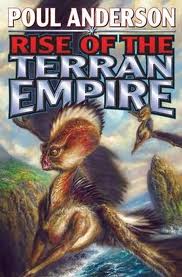My present problem as a blogger is that I have got drawn into rereading parts of Poul Anderson's History of Technic Civilization rather than other works of his that I have read less recently and therefore would find it easier to post about. Of course, a detailed analysis of the Technic History would have to be book-length at least but that is not what I am attempting here.
It is always possible on rereading to find details not remembered from any previous readings. For example, van Rijn's penthouse on the roof of the Winged Cross has a "...VieWall...," thus both "view wall" and "view all" (The Van Rijn Method, New York, 2009, p. 520). This time, not only did I notice that detail immediately but also it struck me as reasonably clever.
I have said before of the Baen Technic Civilization Saga compiled by Hank Davis that I agree with the division of the series into seven omnibus volumes although not with the precise contents or title of each volume except for Volume IV, Young Flandry. I would not insist on volumes of comparable length so I would end the series with Children Of Empire and After The Empire: Long Night And Dawn rather than with Sir Dominic Flandry and Flandry's Legacy. The Legacy volume has Flandry in it which I think is inappropriate.
Of necessity, the Saga broke up earlier collections like Trader To The Stars and The Earth Book Of Stormgate but this turned out not to matter because all the Introductions have been preserved. My only disagreement is that whereas Anderson's own Introduction to The Man Who Counts is presented here as an Afterword to the novel, I would instead have placed it in an Appendix to the entire series in order not to interrupt the flow of the fictitious Introductions. These include not only those from the Earth Book but also the strange perspectives of Noah Arkwright, almost constituting stories in their own right, in The Trouble Twisters.
The Earth Book is not diluted by incorporation into the Saga because it is all here. Although the last Earth Book entry comes after "Rescue on Avalon," its very first entry refers to the Terran War, thus to the events of The People Of The Wind. Thus, the first three volumes of the Saga are an extended Earth Book. In the case of Volume III, I agree with the contents but think that a more appropriate title would have been League And Empire.
The Afterword to "Rescue on Avalon" is immediately followed by the Introduction to "The Star Plunderer," taken from a completely different source, a report by the President of the Galactic Archaeological Society. This must be written a very long time later. First, nowhere else in the History does anyone operate on a "Galactic" scale. Indeed, it is continually emphasized that the Terran Empire occupies only one small part of one spiral arm of the galaxy. Secondly, this report refers to the Terran Empire as the "First Empire" although nowhere else in the entire series is there any hint of a Second.
Further, the report refers to Sol City, Terra, not to Archopolis. The references to a First Empire and to Sol City links this story to another that was tacked on, rather inappropriately, as a conclusion to Anderson's first future history. Thus, just as the Galactic Archaeologists peer into their remote past, the readers gets a glimpse of an earlier stage of Anderson's future historical fiction writing.
Hank Davis did a good job of composing a fictitious Introduction to explain the absurdities of the very early and never before reprinted pulp story, "Sargasso of Lost Starships."

No comments:
Post a Comment